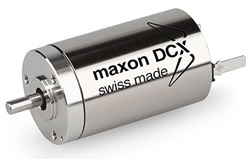
Posted to News on 10th Nov 2017, 13:11
Why DC motors have brushes
Patrick Vega, a Technical Engineer at maxon motor uk, considers why DC motors need brushes.

To understand why DC motors have brushes, we need to know how DC motors operate. Let us begin by looking at the elements that make up a DC brushed motor.
All DC motors are built of three main sub-assemblies: the stator, the rotor and the brush system. The main body of the motor is the stator, consisting of the permanent magnet that is centrally located around the shaft, within the housing and the mounting flange. The permanent magnet is diametrically magnetized with a North Pole and South Pole. The magnet has a bore hole for the shaft of the motor. The magnetic induction comes out of the North Pole into the housing and out into the magnet's South Pole. The housing is made of magnetically conductive material and acts as the magnetic return.
There is an air gap between the permanent magnet and the housing. This creates a strong magnetic field to ensure the winding produces as much force as possible. Too much of an air gap weakens the magnetic flux as air is a bad magnetic conductor. Finding the optimum air gap is always difficult as it depends strongly on the properties of the permanent magnet. Keeping the air gap too narrow only allows space for a thin winding, which restricts lower current density and produces a reduced power density.
The diagram below shows an exploded view of a brushed DC motor.

The rotor is made of the winding and the commutator and this allows the shaft to rotate. In the centre of the motor is the shaft, made of hardened steel to withstand loads for the application, given that the correct motor has been selected. The commutator plate holds the commutator bars and the plate is fixed onto the shaft by a plastic moulding. On the outer diameter of the commutating plate is the self-supporting coreless winding, which is fixed via the welding of contacts to the commutator bars. Glue covers the contacts and welding, giving it mechanical strength. Typically, there can be seven commutator bars and winding segments. The more bars and segments, the smaller the amount of energy must be switched during commutation, which increases service life due to reduced brush fires. Torque produced in the winding will be transferred via the commutator plate to the shaft and this is supported in the stator with either sleeve or ball bearings.
The diagram below shows a detailed view of the rotor.

Finally, the brush system. Brushes can either be graphite or precious metal, with electrical motor connections. To supply power to the rotor we put in place a brush system and each of the brushes has a direct voltage symbol (+/-). The brushes are connected to the commutator bars which allows the current to flow into the winding. Then two rhombic-shaped currents appear near the centre of the poles opposite and in between the winding segments in the magnetic field. The rhombuses are continuously attracted to the strongest magnetic flux, causing the rotor to rotate; but, due to the odd number of commutator bars, they can never meet at the direct opposite poles. Therefore, the rhombuses keep switching into the space in the next approaching segment. This occurs continuously, producing the torque of the motor.
The diagram below shows the commutation arrangement.

Pros and cons of graphite and precious metal brushes

Why are there brushless motors?
As you may already know there are brushless DC motors. So, are they needed? Well, there are some advantages and they are becoming increasingly popular worldwide. This is mainly to do with lifespan. Basically, they have no brushes to wear out. Brushless motors commutate electronically, therefore it is more complex and they require more equipment to run, such as a computer, controller software, controller, wiring/cabling and encoders in most cases. In addition, you need an understanding of the software.
Brushed DC motors only need a DC power supply, two cables and for it to be connected to the motor terminals.
Choosing the wrong motor can be an expensive mistake. To make sure this does not happen contact maxon motor uk to discuss your application requirements, or email [email protected] or telephone +44 (0)1189 7833 337 (please mention MachineBuilding.net).
Want the latest machine building news straight to your inbox? Become a MachineBuilding member for free today >>

















